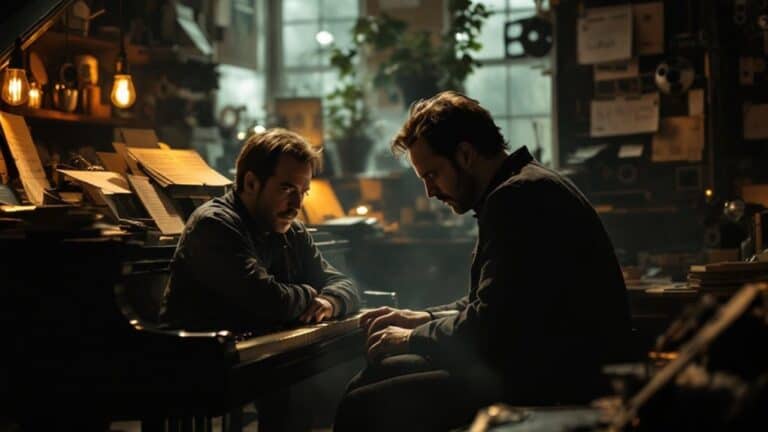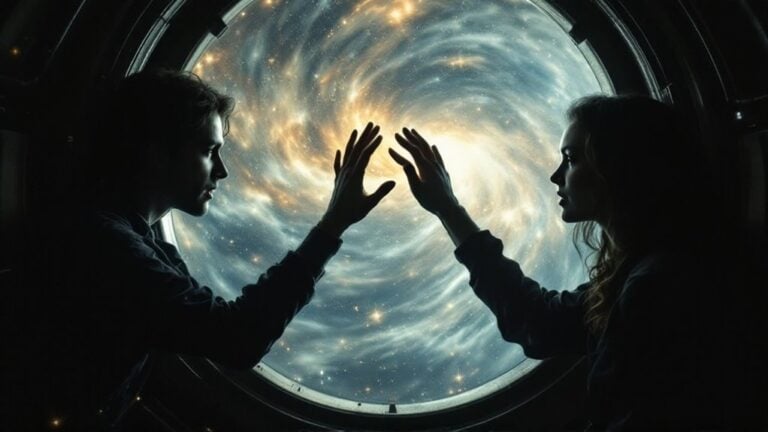Emotional Depth in Nolan’s Filmography
When you explore Nolan’s filmography, you’ll find that emotional depth is intricately woven into his complex narratives. He effectively uses non-linear storytelling to reveal characters grappling with grief, love, and sacrifice. For instance, the poignant father-daughter bond in *Interstellar* illuminates how love can transcend time and space, while *Memento* immerses you in Leonard’s tragic search for identity amid memory loss. Nolan’s innovative cinematic techniques and powerful sound design further enhance the emotional stakes, creating a profound connection with viewers. This blend of emotion and intellectual rigor invites you to reconsider your perceptions of reality and humanity, leaving you compelled to uncover more.
Table of Contents
Key Takeaways
- Nolan’s films explore complex emotional dynamics through non-linear storytelling, revealing characters’ psychological struggles and moral ambiguities.
- Themes of grief and sacrifice are prevalent, illustrating how personal loss shapes character motivations and decisions.
- Love serves as a driving force, depicted through nuanced relationships that highlight the sacrifices made for family and humanity.
- Cinematic techniques, including innovative camera work and sound design, enhance emotional engagement and amplify the impact of key scenes.
- Philosophical inquiries in Nolan’s narratives invite viewers to reflect on existential themes, challenging perceptions of time, reality, and moral dilemmas.
Emotional Narrative Structures
When you immerse yourself in Nolan’s films, you’ll notice that emotional complexity often emerges through non-linear storytelling. This approach cleverly intertwines narrative timelines, allowing you to experience chaos and order simultaneously.
As you navigate these temporal shifts, you’ll find that the psychological dynamics of characters come alive, revealing their emotional disturbances and moral ambiguities. This structure fosters a unique emotional resonance, encouraging you to reflect on themes like morality and the nature of time. The use of flashbacks and multiple perspectives further enriches character development and motivations, deepening your engagement with their struggles. Nolan’s films often explore complex concepts such as temporal paradoxes, which further enhances the emotional stakes for the characters involved.
Ultimately, Nolan’s emotional narrative structures invite you to confront the intricate layers of human experience, making each viewing a profound journey into the psyche.
Balancing Emotion With Intellectualism

While Nolan’s films often explore complex intellectual themes, they never lose sight of their emotional core. He brilliantly combines emotional intelligence with narrative complexity, allowing viewers to connect deeply with the characters.
Consider these elements that showcase this balance:
- Grounding Intellectual Concepts: Films like *Inception* intertwine mind-bending ideas with relatable emotions.
- Character Depth: Characters, such as Leonard in *Memento*, grapple with trauma and moral dilemmas, making their journeys poignant. Nolan’s commitment to character development enriches the emotional landscape of his narratives. His characters often embody heroic traits that reflect their internal struggles.
- Ambiguous Endings: Nolan’s films encourage reflection, leaving you to ponder the emotional and intellectual implications long after watching.
Key Scenes and Their Impact

In Nolan’s films, key scenes often serve as emotional crescendos that resonate deeply with viewers, showcasing themes of grief and sacrifice. You can see this in moments like Cooper’s heartbreaking contact with his children in *Interstellar*, where the weight of time lost becomes palpable, emphasizing the pain of absence. These carefully crafted scenes not only elevate the narrative but also invite you to reflect on the profound connections we share, making each sacrifice feel deeply personal and universally significant. The emotional stakes in *Interstellar* are heightened by Cooper’s struggle between familial duty and saving humanity, highlighting the use of emotional props that deepen character narratives.
Emotional Crescendo Moments
Nolan masterfully crafts emotional crescendo moments that resonate deeply with audiences, leveraging complex character development and thematic depth. These scenes highlight emotional pacing and character arcs, offering viewers profound connections.
Here are three key elements to reflect on:
- Non-Sentimental Approach: He evokes emotion through cerebral storytelling, steering clear of sentimentality.
- Psychological Comedy: Films like *Inception* blend intensity with moments of emotional release, enhancing their impact.
- Musical Swell: The use of music at climactic moments amplifies emotional resonance, creating unforgettable experiences. Nolan’s work often explores how trauma shapes identity, allowing for a deeper exploration of characters’ motivations. Additionally, the portrayal of time as a cage in his films underscores the emotional implications of characters’ struggles, enriching their narrative journeys.
Through these techniques, Nolan constructs rich emotional landscapes, allowing viewers to engage with themes of time, identity, and existence.
Each crescendo serves not just as a plot device, but as a transformative experience that deepens your understanding of the characters and their journeys.
Grief and Sacrifice Themes
Grief and sacrifice intertwine profoundly in Christopher Nolan’s films, creating a tapestry of emotional complexity that captivates audiences.
In Inception, Dom Cobb’s grief symbolism manifests through his haunting memories of Mal, culminating in a poignant climax where he confronts and ultimately lets her go.
Similarly, Memento illustrates the devastating effects of Leonard Shelby’s grief-driven quest for vengeance, showcasing how it distorts his reality.
Meanwhile, Interstellar explores sacrifice dynamics through Joseph Cooper’s heart-wrenching decision to leave his daughter for humanity’s survival, contrasting with Doctor Mann’s selfish choices.
Each key scene resonates deeply, emphasizing that grief can consume lives while sacrifice often reveals the noblest and most flawed aspects of human nature, inviting you to reflect on your understanding of love and loss.
The Influence of Paratextuality

In exploring the influence of paratextuality in Nolan’s films, you’ll find that rhetorical analysis techniques reveal layers of meaning often hidden beneath the surface.
As you engage with viewer interpretation dynamics, consider how your personal experiences and perspectives shape your understanding of complex narratives.
The meta-narrative complexity in films like Inception and Interstellar not only challenges traditional storytelling but also invites you to rethink what it means to engage with a story, making every viewing a unique experience.
Rhetorical Analysis Techniques
How does paratextuality shape your understanding of a film? Paratextual analysis reveals how various elements influence your viewing experience and interpretation.
Consider these key aspects:
- Entryway Paratexts: Trailers and posters set your initial expectations, framing how you approach the film.
- In Medias Res Paratexts: Elements like opening credits guide your understanding as the story unfolds, creating context.
- Publisher-Created Paratext: Marketing strategies shape perceptions and can even alter emotional responses.
These media influences highlight how paratexts aren’t mere extras; they actively engage you, conditioning your emotional connection with the narrative.
Viewer Interpretation Dynamics
While engaging with a film, it’s essential to recognize that paratextual elements shape your interpretation and understanding of the narrative. These elements guide your viewer expectations, providing context-dependent interpretive frames that activate your knowledge about genre, style, or the filmmaker’s intentions.
As you step into a film’s world, paratexts act as a vestibule, influencing how you engage with the story and its characters. They create a threshold where off-text discussions enrich your experience, leading to deeper connections.
Meta-Narrative Complexity
Although paratextuality often operates in the background, it plays an essential role in shaping the meta-narrative complexity found in Christopher Nolan’s films. This complexity invites you to explore deeper meanings and engage in discussions well beyond the screen.
Consider these aspects:
- Continuous Conversations: Paratexts create ongoing dialogue surrounding the film.
- Rewatchability: The intricate meta narrative layers encourage you to revisit and reinterpret the story.
- Narrative Ambiguity: Ambiguous endings provoke thought and diverse interpretations.
These elements intertwine, crafting a narrative landscape that challenges your understanding.
Nolan’s films, like *Inception* and *Interstellar*, exemplify how paratextuality cultivates a rich tapestry of ideas, compelling you to piece together complex narratives and reflect on the profound themes he presents.
The Role of Sound and Music

Nolan’s films are masterclasses in the use of sound and music, as they often serve to deepen the audience’s emotional engagement with the narrative. Through sound manipulation and dynamic scoring, he crafts immersive experiences that resonate profoundly.
Techniques like the Shepard Tone create auditory illusions, enhancing suspense building and emotional resonance. His collaborative efforts with composers, particularly Hans Zimmer, guarantee thematic motifs weave throughout, maintaining consistency and depth.
Nolan also employs experimental techniques, using authentic sound recordings and silence to heighten tension and create a cinematic atmosphere. By layering sound effects within music, he enriches storytelling, inviting viewers to feel every moment more intensely.
Fundamentally, sound and music aren’t mere embellishments; they’re crucial components of his emotional tapestry.
Love and Humanity Themes

Love and humanity intertwine seamlessly in Christopher Nolan’s films, revealing profound truths about the human experience. In Interstellar, love’s transcendence plays a pivotal role, showcasing how emotional sacrifice can guide our decisions.
You’ll find:
- The father-daughter bond between Cooper and Murphy, illustrating love’s power to defy time and space.
- The difficult choices characters face, emphasizing that love often demands sacrifice for greater purposes.
- The nuanced portrayal of emotions, as characters navigate loneliness, guilt, and the weight of their decisions.
Nolan emphasizes that love isn’t just an emotion; it’s a transcendent force that can drive us to the brink, urging you to trust it, even when the path isn’t clear.
His exploration invites you to reflect on the complexities of your own relationships.
Conclusion
In exploring emotional depth across Nolan’s filmography, you uncover a fascinating interplay between intellect and feeling. Each film, with its intricate layers, invites you to reflect on the shared human experience, drawing unexpected connections between characters and their struggles. Whether it’s the haunting score or a pivotal scene, these elements resonate deeply, reminding you that coincidence often shapes our lives, just as it does in Nolan’s narratives. Ultimately, his work challenges you to embrace both emotion and intellect in your own story.







